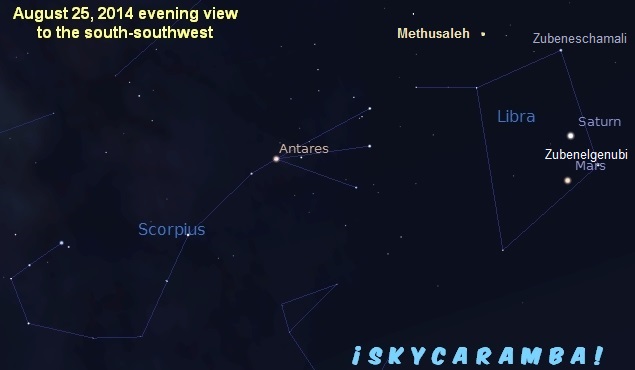¡SkyCaramba! Weekly astronomy blog for the week ending August 23, 2014
A few weeks ago, I told you about two planets lining up between two bright stars in our evening sky. Next week, one of the planets passes the other and keeps going.
Mars is leaving Virgo and entering Libra. In a few more weeks, it will leave Libra and keep heading east toward Scorpio. While it’s in Libra, it passes south of Saturn.
The named stars of Libra are Zubenelgenubi and Zubeneschamali. You are correct if you think they might refer to different parts of the same thing because their names start so much alike. Zubenelgenubi is Arabic for “southern claw”. Zubeneschamali means “northern claw”. These names go back to a time before the Romans looked to that part of the sky and saw the scales. These used to be the claws of Scorpio.
These two stars do have lesser known Latin names. The southern scale is Lanx Australis and the northern scale is Lanx Borealis. They are typically held out as the scales of justice. However, at the height of the Roman Empire, the sun was in Libra during the September equinox. Night and day were of equal length. The constellation also straddled the line between the northern and southern halves of the sky. Now that’s some balance!
Zubenelgenubi is actually a multiple star system. There may be as many as five stars orbiting each other. Although this group is just 76 light years away, the stars are so close together not all of them can be seen with a telescope. It should be easier to resolve them as they get closer. They are approaching us at about 6 miles per second. At that rate, it will take about 2.3 million years to pass our sun.
Zubeneschamali should pass us sooner, in just 1.6 million years. It’s 185 light years away but moving much faster at 21 miles per second. It appears to be a single star.
Ancient astronomers have given us a puzzle about Zubeneschamali. More than 2,000 years ago, they said it was brighter than Antares, the bright orange star in Scorpio. A few centuries later, Ptolemy said Zubeneschamali and Antares were of equal brightness. Today, Antares is certainly the brighter of the two. Is one getting dimmer or is the other getting brighter? For all we know, the ancient accounts could be the products of imperfect observations of two stars that have never changed brightness.
Mars will pass south of Saturn on the 25th. To the west and sort of in between you will see Zubenelgenubi. If your sky is dark and you have binoculars or a telescope, you may try to see a star nicknamed Methusaleh. It’s regarded as the oldest known star in the universe, on the order of 13 to 15 billion years old. On star charts, it gets less literary designations like HIP 76976 and HD 140283, depending on which scientific cataloging system is used.
Enjoy the view. ¡SkyCaramba!
http://www.constellation-guide.com/constellation-list/libra-constellation/
